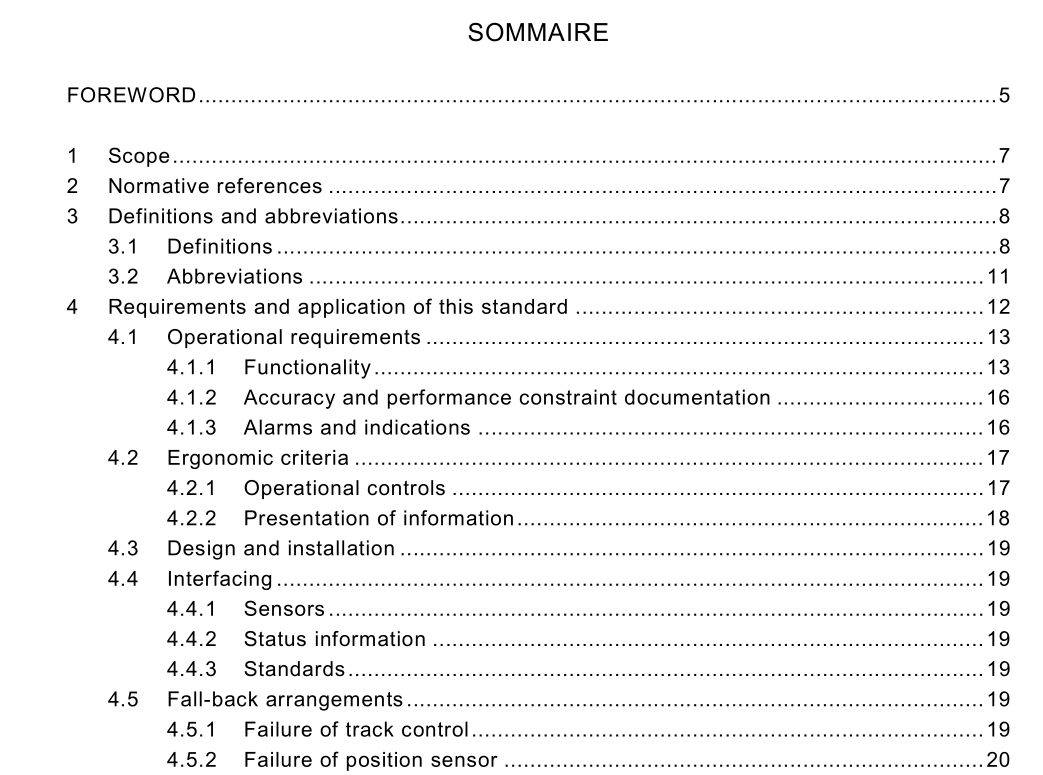IEC 62065 pdf download

IEC 62065 pdf download.Maritime navigation and radiocommunication equipment and systems – Track control systems
1 Scope
This International Standard specifies the minimum operational and performance requirements, methods of testing and required test results conforming to performance standards adopted by the IMO in resolution MSC.74(69) Annex 2 Recommendations on Performance Standards for Track Control Systems. In addition it takes into account IMO resolution A.694 to which IEC 60945 is associated. When a requirement of this standard is different from IEC 60945, the requirement in this standard shall take precedence. NOTE All text of this standard that is identical to that in IMO resolution MSC.74(69), Annex 2, is printed in italics and the resolution (abbreviated to – A2) and paragraph numbers are indicated in brackets i.e. (A2/3.3).
2 Normative references
The following referenced documents are indispensable for the application of this document. For dated references, only the edition cited applies. For undated references, the latest edition of the referenced document (including any amendments) applies. IEC 60945, Maritime navigation and radiocommunication equipment and systems – General requirements – Methods of testing and required test results IEC 61 1 08-1 , Global navigation satellite systems (GNSS) – Part 1: Global positioning system (GPS) – Receiver equipment – Performance standards, methods of testing and required test results IEC 61 1 08-2, Maritime navigation and radiocommunication equipment and systems – Global navigation satellite systems (GNSS) – Part 2: Global navigation satellite system (GLONASS) Receiver equipment – Performance standards, methods of testing and required test results IEC 61 1 62-1 , Maritime navigation and radio communication equipment and systems – Digital interfaces – Part 1: Single talker and multiple listeners IEC 61 1 62-2, Maritime navigation and radio communication equipment and systems – Digital interfaces – Part 2: Single talker and multiple listeners, high speed transmission
3 Definitions and abbreviations
For the purposes of this standard, the following definitions and abbreviations apply. 3.1 Definitions 3.1.1 active track track activated for track control 3.1.2 alarm audio and visual signal announcing a condition requiring attention. The audio continues until acknowledged. The acoustic noise pressure of the alarm is at least 75 dBA but not greater than 85 dBA at a distance of 1 m (IEC 60945). The visual indication continues until the alarm condition is removed 3.1.3 along track speed control automatic control of the ship’s speed during track control based on a pre-planned track 3.1.4 assisted turn manoeuvre of a ship from one straight leg to the next automatically controlled by a pre-set radius or rate of turn but not based on the ship’s position 3.1.5 back-up navigator any individual, generally an officer, who has been designated by the ships master to be on call if assistance is needed on the bridge 3.1.6 consistent common reference system sensor input data, providing identical and obligatory reference pertaining to position, course, heading, bearing, speed, velocity, etc. and horizontal datum to different sub-systems within an integrated navigation system 3.1.7 course for marine navigation, course is the horizontal direction in which a vessel is steered or intended to be steered, expressed as angular distance from north, usually 000° at north, clockwise through 360°.3.1.8 course difference limit maximum difference between track course and heading before an alarm is activated 3.1.9 cross track distance (also known as cross track error) perpendicular distance of the ship from the track including direction (negative if the ship is left of the intended track) 3.1.1 0 cross-track limit maximum cross track distance before an alarm is activated.3.1.1 1 curved track non-straight track between two straight legs 3.1.1 2 fall-back arrangements automatic reaction of the system to a failure to provide the best possible functionality 3.1.1 3 FROM-waypoint the last passed waypoint 3.1.1 4 great circle sailing sailing on the intersection of the earth surface and a plane containing the points A, B and the centre of the sphere 3.1.1 5 heading the horizontal direction in which a ship actually points or heads at any instant, expressed in angular units from a reference direction, usually from 000° at the reference direction clockwise through 360° 2 3.1.1 6 heading control control of the ship’s heading 3.1.1 7 heading monitor function Monitoring the actual heading sensor by an independent second source









